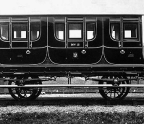
Introduction
Of all the Atlantic types which ran on the railways of Britain, none faced greater challenges than did those of the North British Railway, as every line that they traversed was fraught with difficulties. The Waver ley Route was arguably the most formidable main line in the country, rising twice to summits over 900 feet above sea level in the 98½ miles between Edinburgh and Carlisle. Southbound trains had first to battle with a nine-mile climb at 1 in 70 to Falahill which was followed by ten miles of 1 in 80 (often from a standing start) at Hawick to reach Whitrope Summit. Had the Atlantic routes been planned as a test of stamina and strength for locomotives and their crews the designer could not have achieved a better outcome. Many of the main stopping stations were located at the foot of a gruelling ascent. Dundee, Stonehaven, Montrose and Inverkeithing all fell into this category whilst trains heading south from Perth were soon confronted by over six miles at 1 in 70 on the climb to Glenfarg. Even Edinburgh got in on the act with almost two miles at 1 in 78 from St. Margaret's to the buffer stops at Waverley station. A signal stop for an express at St. Margaret's was something that drivers dreaded, but experienced all too often when the station was suffering from congestion.

This was the environment into which the North British Atlantics were thrust in 1906.
The rebirth of a railway
The story of these locomotives is as much about men as it is about machines and a milestone without which they may never have appeared at all took place on 23rd March 1905. On that day the North British Railway announced the death of its Chairman, George Wieland, whose autocratic control of company affairs had allowed the NBR to lose considerable ground to its rivals the Caledonian Railway during the previous twenty years. Wieland was an accountant who happened to be in charge of a railway and his skills lay in being able to impress shareholders with financial statistics boasting a fleet of 800 locomotives having an impressive capital value. Whether or not the locomotives concerned were fit for purpose was not an issue which troubled George Wieland who was a ‘mend and make do’ protagonist. Matthew Holmes, the locomotive superintendent, had tried to obtain the go -head to build a desperately needed more powerful type of locomotive but his requests never got beyond the boardroom door.

Weiland's successor, the Earl of Dalkeith, was in no doubt about how the future should develop and time was not lost in the quest for ‘our new passenger locomotive’. Time was not in the NBR's favour as it was already an open secret that the Caledonian was building a new ‘super




